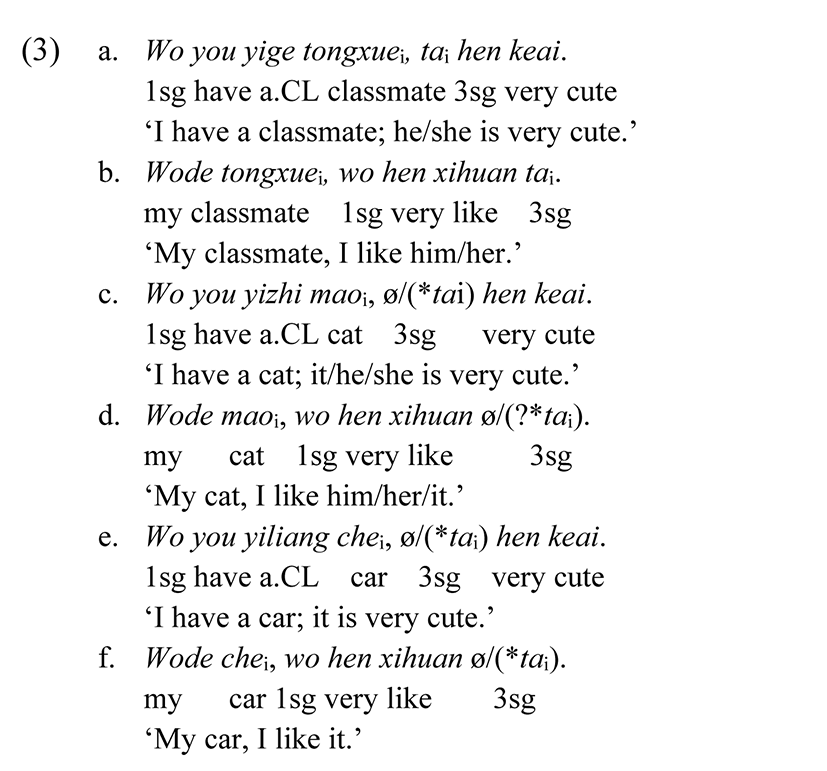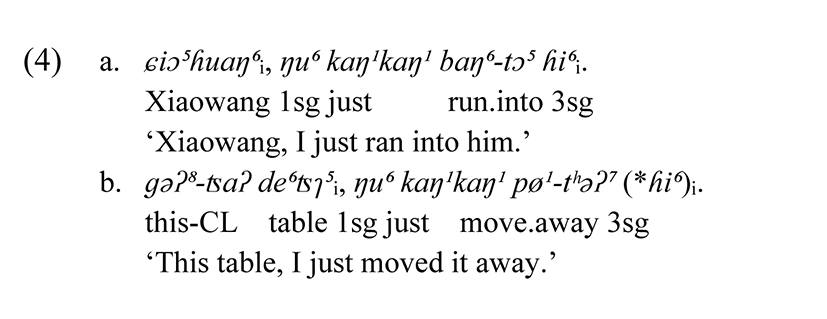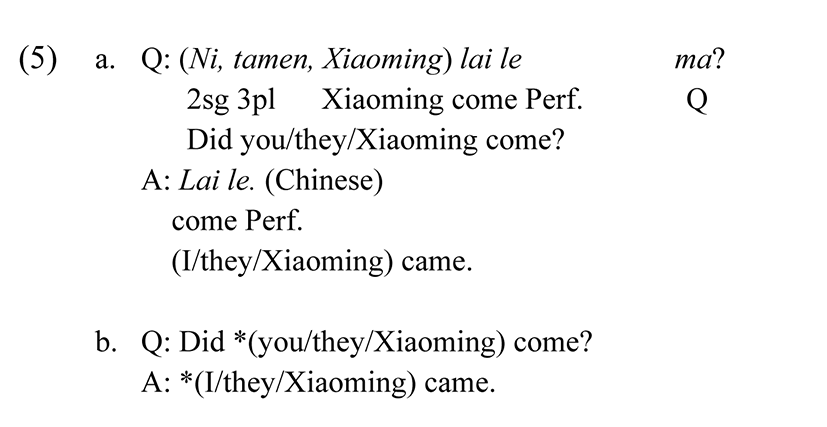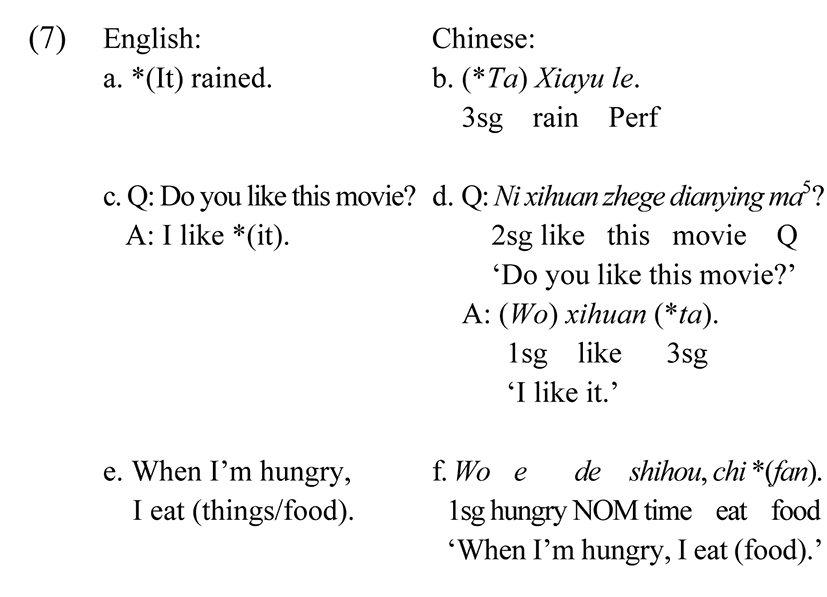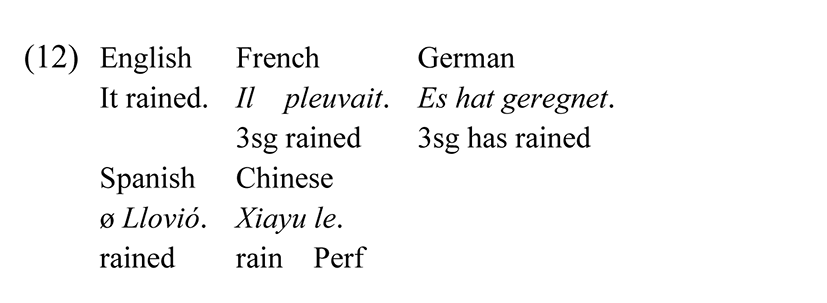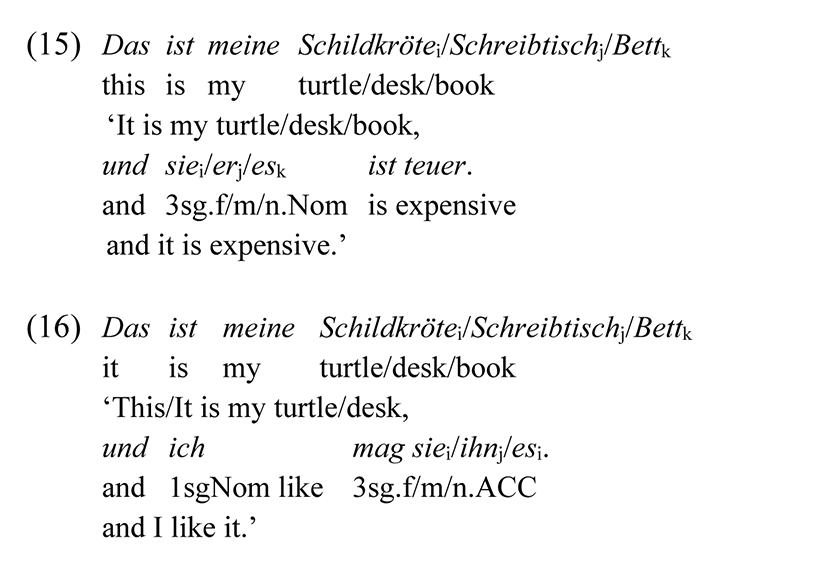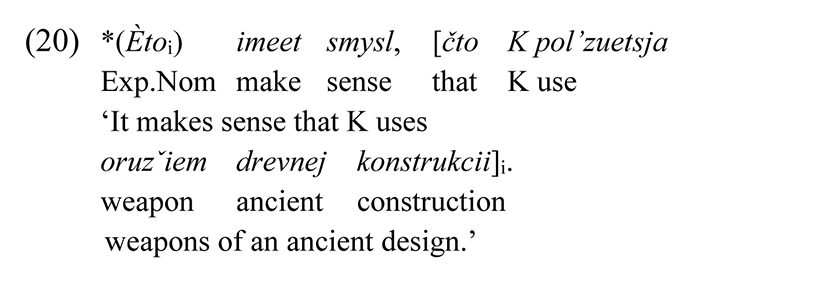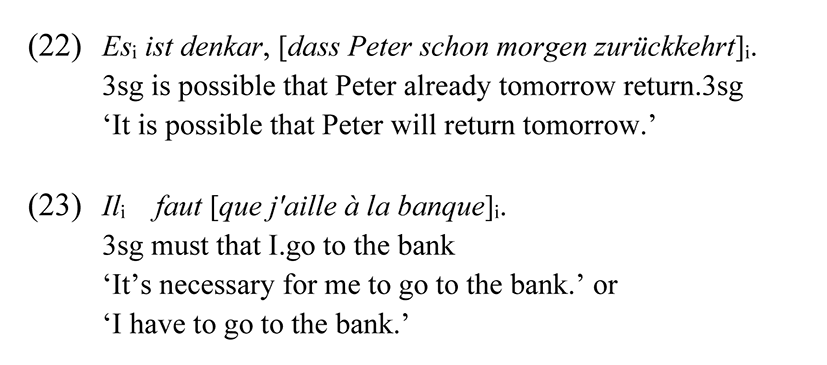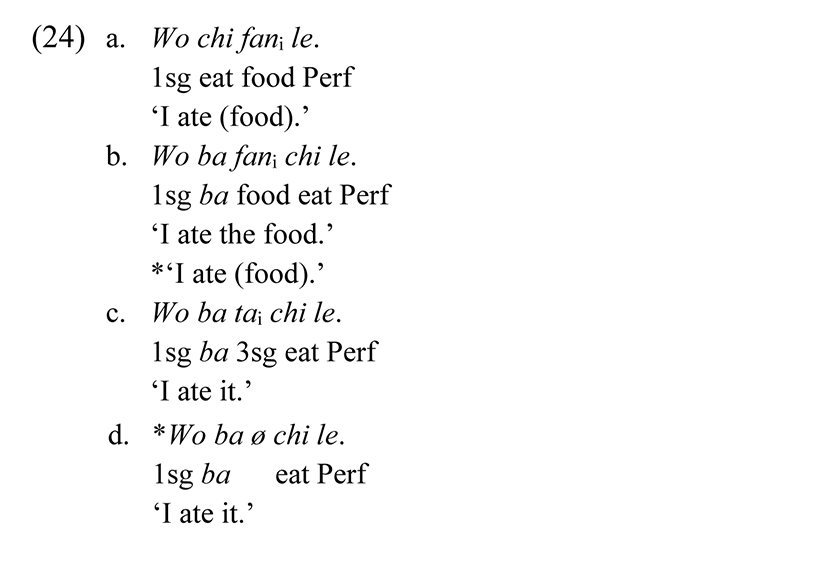1. Introduction
In this article, after surveying data from Chinese and other languages, I argue that both the English dummy subject and non-human personal pronoun its in (1) are ultimately expletive pronouns, thanks to the combined effects of the EPP1 (Chomsky 1982), ban against null non-generic objects (Haegeman 1987), and the Animacy Hierarchy (Silverstein 1976). Beyond English, I suggest that, typologically, the lack of exclusive inanimate third-person pronouns seems to be a universal tendency; they very often share the same form as the dummy subject or a demonstrative.
I will also reevaluate the categorization of Chinese as a radical pro-drop language that can drop its pronouns with few restrictions (Neeleman & Szendrői 2007) with the help of the expletive object inanimate pronoun found in the ba-structure.
2. Expletive and Null Pronouns
It in English can either function as an expletive dummy subject (1a) or a referential singular third-person non-human pronoun (1b).
According to Postal and Pullum (1988), expletives are morphologically or discoursally identical to a proform, which is non-referential and has a vacuous semantic role. As required by EPP, it in (1a) fills a subject argument position for the weather verb torain that does not project a theta-role to this position. It in (1b) refers to the non-human animate turtle or the inanimate desk. For human or personified beings, the gendered he/him/his or she/her/her would be used as a third-person singular pronoun, as shown in (2):
While English distinguishes genders only for singular pronouns referring to human(-like) entities, or nouns of high sentience and animacy (Silverstein 1976), such as Mary or pets, Mandarin Chinese, as shown by the contrasts below in (3c)–(3f), has no pronouns for non-human or inanimate entities, or nouns of lower sentience and animacy, such as mao ‘cat’ or che ‘car.’ In other words, low-animacy nouns are represented by covert null pronouns in Chinese; overt pronouns are reserved only for high-animacy nouns, such as the human tonxue ‘classmate’ in (3a) and (3b). (3a), (3c) and (3e) are examples of personal pronouns and null pronouns, i.e., ø, surfacing in the subject position, while (3b) and (3d), (3f) are examples of personal pronouns and null pronouns used in the object position:
The avoidance of overt low-animacy, or non-human and inanimate, pronouns is productive among Chinese dialects. It happens, for example, in Shanghainese (Zhu 2023), Wu Chinese, as well, where an inanimate de6tsɿ52 ‘table’ cannot be referred to by the third-person singular pronoun ɦi6, while Xiaowang, a human, can. Compare (4a) and (4b).
3. Types of Pro-Drop Languages and Subject-Drop Versus Object-Drop
Not all languages have the (phonological) EPP requirement (Holmberg 2005). As shown above in (3c)–(3f) and (4b), in Chinese, null subjects or null objects are required for low-animacy antecedents, such as cat, car, or table. The absence of pronouns is made possible by the fact that Chinese is a discourse-oriented pro-drop language, in which the dropped pronouns can be recovered from the context. Depending on the language, in context-based pro-drop languages, pro-drop can refer to topic-drop, subject-drop, or object-drop (Huang 1989, Tomioka 2003, Holmberg 2005). (5a) shows how Chinese, being a pro-drop language, can drop the subject in the question-answer situation, when the context is clear; and (5b) shows how English, not being a pro-drop language, must keep all the pronouns and nouns intact.
In contrast, recovery of the dropped subjects in Arabic- or Spanish-type languages that have rich verbal conjugation relies on the Agr feature of the verb. This type of concord might explain why these pro-drop languages have more restrictions on object-drop. Object-verb agreement is much less common than subject-verb agreement cross-linguistically (Koopman 1984). Consequently, pro null objects are far more marked than pro null subjects (Wang et al. 1992, Runner 2000, Jarrah et al. 2023).
Chinese-type pro-drop languages, such as Thai and Vietnamese, are also called radical pro-drop languages (Neeleman & Szendrői 2007) in that they tend to have simpler verbal agreement or pronominal variations. For example, they tend to have invariant pronouns when it comes to case marking: the Mandarin ta and Shanghainese ɦi⁶ are the only third-person singular pronouns, regardless their pre-verbal or post-verbal positioning in a sentence, as already shown in (3) and (4).
The English high-animacy human third-person singular pronouns he/she and him/her decline for the nominative and accusative cases, despite that the non-human lower-animacy it does not. This is the same scenario for it’s predecessor hit in Old English (Allen 1986)3. It is caseless, less specific with morphological features, as lower-animacy and expletive pronouns are expected to be. For example, the only other expletive pronoun in English, there, as is used in the existential structure in (6), has only one invariant form and does not trigger agreement or assign case and serves only the purpose of satisfying EPP (Chomsky 1995, Kayne 2019). The same can be said of the German inanimate pronoun es that will be discussed in Section 6.
Because there is no need for an overt subject, pro-drop languages do not need a dummy subject like the English it. As shown in (3) and (4), null pronouns (ø) in Chinese are very often the counterparts of the English it.
Pertaining to subject drop, Jaeggli and Safir (1989) propose the Null Subject Parameter, which suggests that null subjects are permitted only in languages with morphologically uniform inflectional paradigms. They are either consistently complex or consistently impoverished, the former represented by Arabic, Spanish, Italian, and Hungarian that rely on Agr (Dalmi 2024), and the latter by Chinese and Japanese that rely on the context. English, French, and German, however, have in-between inflectional paradigms, and, therefore, do not allow null subjects and are non-pro-drop languages.
(7) compares how English and Chinese differ in overt and covert pronominal usages in subject and object positions. In addition to the well-known cases of expletive subjects versus null subjects in weather verb constructions, shown in (7a) and (7b), (7c)–(7f) illustrates how English allows the omission of generic objects like the more general things and food, but not the referential ones like the more specific this movie and it, whereas Chinese does the opposite: it can drop referential lower-animacy pronouns like ta for dianying ‘movie,’ but not the generic objects like fan ‘food’ (Haegeman 1987, Liu 2017)4:
In order to account for the occasional referential object drop in the so-called RWR (Reduced Written Register) in English, for example, those like (8) found in recipe books, Haegeman (1987) resorts to a movement (object topicalization) followed by truncation (deletion of the fronted object in the left periphery) analysis, which is in the same vein as Huang (1989)’s generalized analysis of Chinese topic-, subject-, and object-drop:
I further argue that, from the angle of human and non-human differentiation, in recipe writing, objects of the verbs are more likely to be inanimate non-human nouns as ingredients or utensils. RWR proves again that it is a universal principle that non-human or inanimate nouns and pronouns have a better chance to be omitted, as I have shown in the Chinese data (3) and (4).
4. Pronoun-Worthiness and the Hierarchy of Linguistic Animacy
Pronoun-worthiness tied to the degree of animacy is cross-linguistically robust; for example, in addition to (4), the Shanghainese data, in Burmese and Tagalog, pronouns are strictly personal, referring only to human beings (Bhat 2004, Nyame & Ebule 2022). In (9), for example, the human student in Tagalog, itong estudyanteng, is referred to with the pronoun siya in both the subject and the object positions, but that is not the case for the non-human desk, mesa.
Kratzer (2009) and Siewierska (2004) point out that languages that lack third-person pronouns are more common than languages that lack first- or second-person pronouns. Low-animacy inanimate pronouns are always third person, which are different from the first person and second person that are always human(ized) and of high animacy, directly referential, without nominal antecedents (Elbourne 2005). Besides not having third-person pronouns for lower animacy in pro-drop languages like Chinese, Burmese, and Tagalog, it is not uncommon for languages to use demonstratives to replace third-person pronouns, which include inanimate pronouns. For example, in Tagalog, in some situations, mesa ‘desk’ can be referred to with the demonstrative ito. According to Feature 43A on the World Atlas of Language Structures (WALS) wals.ino (Dryer & Haspelmath 2013), in about 56% of the 225 investigated languages, third-person pronouns and demonstratives are related. Mingkai (1986) believes that, historically, Old Chinese did not used to have third-person pronouns; they have been derived from other non-pronominal elements that have deictic functions.
As per the linguistic AH laid out by Silverstein (1976) below, all entities are stratified by their level of sentience or animacy that privileges humans, especially the first-person and second-person pronouns that are always humans and actively involved participants present at every ongoing conversation. What follows is that third-person pronouns are ranked higher than nouns, even nouns related to humans; this indicates that, on average, pronoun-worthiness is an embodiment of high animacy.
first-person pronouns > second-person pronouns > third-person pronouns/demonstratives > proper nouns > human > animate > inanimate
AH bears extensive and fundamental consequences on grammar in human language (Becker 2014, Liu 2023); for example, its effects can be seen in the commonly used possessive of-structure in English: Inanimate possessors like the world are better fits than the animate possessor professor for the of-structure. Compare professor’s map, ?*map of the professor, and map of the world. The animacy effects have also been reported in Navajo word order (Young & Morgan 1987), Russian accusative case declension (Cubberley 2002), and the ergative case formation of Umpithamu, a Pima-Nyungan language (Verstraete 2010), among numerous other cases.
I have shown above how pronounhood and pronominal gender distinction are reserved only for higher animacy in Chinese and English, respectively. It is worth pointing out that although linguists like Corbett (1991) have been discussing the relationship between gender and animacy in English, very few Chinese linguists have studied the connection between pronounhood and animacy in Chinese (cf. Liu 2023). On the other hand, the absence of pronouns and genders for non-humans and inanimates corroborates the Avoid Pronoun Principle in the design of language from the perspective of the Minimalism Program (Chomsky 1995). Altogether, there should be more non-human existences than humans in this physical world, and the Avoid Pronoun Principle should be more prevalent. The Avoid Pronoun Principle avoids or reduces referential (phi/ϕ-) features that serve the purpose of identification; “the pronominal elements should be as empty as possible of referential content” (Picallo 1994: 274), such as information regarding person, number, and gender. That said, an obligatory null pronoun, as in the case of Chinese non-humans and inanimates in (3) and (4), would be the most economical and faithful way to satisfy the Avoid Pronoun Principle. The lack of lower-animacy pronouns also fulfills Gricean’s quantity maxim (Grice 1975); i.e., the referential grid of a pronoun that consists of person, number, and gender, etc., should be as unspecified as possible. Picallo (1994) argues that, compared with animates, inanimates do not have notional gender and number, and they are universally non-person (Benveniste 1966). Their property of being inherently featureless leads to the use of pro or empty categories like null pronouns in many languages. Such a pattern has also been observed in the evolution of Esperanto and other artificial languages (Yakovlev 2003). Comrie (1989) generalizes that higher-sentience, i.e., higher-animacy entities, are treated more as individuals and therefore countable and definite, while entities of lower sentience or lower animacy are more readily perceived as an indeterminate mass.
5. Unified Account of the English Its
Based on the contrasts between Chinese and English pronominal usages shown in (1), (2), (3) and (7), as well as the universal that lower-animacy inanimate pronouns are often replaced by null pronouns or demonstratives (Comrie 1989), I argue that the referential it in English (1b) is ultimately expletive as well. I contend that the it in (1b) is tasked with the same function as the dummy subject it in (1a), i.e., to satisfy the mandate that null subjects or null non-generic objects are not allowed in English. Lower animacy, what it is supposed to refer to, is frequently deprived of pronounhood typologically. In other words, English does not have personal pronouns exclusively reserved for lower animacy. What we see is the dummy it, a placeholder, fulfilling the otherwise illicit empty categories.
They, the plural third-person pronoun, on the other hand, can refer to both higher-animacy and lower-animacy beings. In fact, when they is used as a gender-neutral singular third-person pronoun, it can only refer to humans; compare (10a) and (10b). As a result, they cannot be used as an expletive as shown in (10c), because of its partial association with higher animacy:
The lack of exclusive low-animacy pronouns in a non-pro-drop language can be seen in French and German, that are genetically close to English as well. For example, in French, because of its dual-gender division among nouns, there are two third-person singular pronouns: il for masculine and elle for feminine. Lower-animacy shares these two gendered pronouns with higher-animacy humans for third-person singular reference, depending on their grammatical genders. An argument can certainly be made that the high animacy of French borrows its pronouns from low animacy, instead of the other way around. One tentative counterargument can be that the well-known fashion magazine Elle definitely targets women, not any nominals with the feminine gender.
Also, because of its nominal gender distinctions, French does not have a designated lower-animacy referential pronoun like the English neuter it.6
Nevertheless, il, like it, can also function as the dummy subject in French, as shown by the comparisons in (12), between English, French, and German, the three non-pro-drop languages, and Spanish and Chinese, the two pro-drop languages. Roughly, the functions of the German dummy subject es match those of the English it as well; es is also a singular pronoun for mostly inanimate nouns, which I will add detail to in Section 6:
Interestingly, in addition to the French il, it can also match the French ce, which is the demonstrative pronoun counterpart of the English this, as also shown above in (11). For example, in French, the English questions inquiring the identity of a low-animacy being what is it? and what is this? are translated the same into French:
Once again, we see the connection between low animacy and demonstratives, as mentioned above (Comrie 1989). Substituting pronouns with demonstratives for lower animacy is frequently reported in languages. For example, the Chinese equivalent of English what is it? is zhe shi shenmo? but not *ta shi shenmo?:
Ta shi shenmo is fine if it addresses the identity of higher animacy, for example, the profession of a person.
6. A Comparison of English, French, and German, Three Non-Pro-Drop Languages
This section intends to further prove that the merger of the English its for expletives and lower animacy is not random or confined only to English; instead, such a union happens frequently among non-pro-drop languages.
First, it is useful to note that non-pro-drop languages like English, French, and German are not common. According to wals.info (Dryer & Haspelmath 2013),7 under Feature 101A: Expression of Pronominal Subjects, by far the majority of the world’s languages, 711 surveyed, are pro-drop or partially pro-drop languages.8 As shown below in Table 1, only 82 of them, i.e., 11.5% of the 711 languages, mostly Germanic and Niger-Congo languages, require an obligatory pronoun in the subject position. The other 629 languages, i.e., 88.5%, allow pro-drop, in different forms and to different degrees.
Second, the English it is a unique pronoun in non-pro-drop languages, complicated mainly by the deficiency of gender-marking in English. Despite them all being non-pro-drop languages that also do not allow null referential objects, one important difference between English and French and German, however, is that the latter two have grammatical genders on their nouns, which English does not. As a result of grammatical gender marking, gendered pronouns like the French il and elle in (11) and the German er and sie in (15) and (16) do not necessarily always signal higher animacy as English he and she do. In (15) and (16), sie refers to the feminine noun Schildkröte ‘turtle’ and er refers to the masculine noun Schreibtisch ‘desk.’ Both turtle and desk belong to non-human lower animacy.
In addition to masculine and feminine nouns, German also has neuter nouns that are most typically genderless inanimates (Pekelis 2018), with es being their third-person singular pronoun.9 (15)10 and (16) are how er, sie, and es appear in the subject and object positions, respectively:
Not surprisingly, the lower-animacy neuter es is also a homophone of the expletive in German, just like it. For example, in (17a) and (17d), in turn, es is used as the dummy subject in the existential structure,11 with the impersonal weather verb regnen ‘to rain,’ anticipatorily referring to the temporal clause headed by wenn ‘when,’ and introducing the subordinate clause in the extrapositional structure. Es behaves almost exactly the same as its English counterpart it as we have seen in (1) and (12):
In wals.info (Dryer & Haspelmath 2013), about 43.5% of the investigated languages (112/257) distinguish grammatical genders on nouns or pronouns. German and French belong to this slightly marked group, which makes them highly marked for being non-pro-drop and grammatically gendered at the same time, which accounts for about 5% of the world’s languages. It is, however, less clear whether English should be characterized as a gendered language or not, because English has a (somehow impoverished) pronominal gender system. English distinguishes gender only in singular pronouns for human-like entities, but not for its nouns or other pronouns.12
Some linguists consider it overdifferentiating to classify English as a language with gender, since gender is less central to its syntactic structure (Bloomfield 1933, Palmer 1971). Corbett (1991), however, uses the agreement between the personal-pronoun antecedents he and she and the reflexive anaphors himself and herself as a criterion to treat English as a language with gender. The debate over whether English has gender is beyond the scope of this paper, but it carries weight when it comes to deciding how representative or significant my finding is cross-linguistically accurate:
in a non-pro-drop language that (disallows null referential objects, which can be considered as a property related to pro-drop, and) has an inanimate pronoun, the inanimate pronoun would be homophonous with the expletive pronoun.
I have shown that it proves to be very unique and does not have many perfect matches in other languages. But the above surveys I have made of English and other languages, some its close relatives and some completely unrelated, have displayed some common patterns: (1) there is a lack of exclusive pronouns for low-animacy entities, and (2) non-human pronouns, if needed, tend to be the same as the expletive pronoun in a non-pro-drop language.
7. Weak Dummy Pronouns
The use of the dummy subject il in French is comparable to its counterparts it in English and es in German, as shown in (12). In the direct object position, however, like all the other French direct object pronouns, the clitic form of il, i.e., le, is employed. Le is also the definite masculine article, which, once again, proves the close connection between demonstratives and (inanimate) third-person pronouns:
Although, unlike the English it and German es, there is a discrepancy between the nominative and the accusative forms of il, we can still argue that il and its clitic object form, le, are place holders to satisfy the requirements of EPP and of no null referential objects.
What kind of pronoun is a clitic? According to Cardinaletti and Starke (1999), there are three types of pronouns: strong, weak, and clitic. They decrease successively in terms of the D feature, i.e., the level of definiteness reading. Strong pronouns are independent and can stand alone, like I in English, ni ‘you’ in Chinese, and elle ‘nominative third-person feminine singular’ in French. French direct object clitics such as le and la in (18) are deficient with the definite interpretation and have less functional structure and, therefore, have to undergo movement to the adjunction position of the verbal head, vois ‘see.’
The definiteness strength of weak pronouns lies between that of strong pronouns and that of clitics. Pérez (2014) suggests that, for example, in (19), ello ‘it’ in El Cibao variety of Dominican Spanish (DSEC) is a weak pronoun. The otherwise unacceptable dummy subject pronoun ello in a pro-drop language is a result of DSEC pronouns being weakened and left with an unstable definiteness feature. Being weak, ello is a quasi expletive that still has ϕ features such as person and number but lacks D that can enable it to (co)refer (Cardinaletti & Starke 1999). This also makes DSEC Spanish a partial pro-drop language.
Pekelis (2018) relates the traits of a weak pronoun to the Russian èto in (20). Russian is yet another pro-drop language. Èto is both an expletive subject and a referential pronoun in the extraposition structure. Analyzing the otherwise prohibited dummy subject éto as a weakened referential pronoun accounts for its obligatory but uncharacteristic surfacing in a pro-drop language:
The weak-pronoun treatment of the unconventional expletive subjects in pro-drop languages has been extended to the expletives in the extrapositional structures in non-pro-drop languages like English, French, and German, as shown in (21), (22) and (23) (Holmberg 2005, Bartra 2011, among others). In the English extrapositional structures like ‘it is nice to/that/when…’, it is co-indexed with the non-nominal infinitive, subordinative, and adverbial clauses that do not have a strong definiteness feature to start with. It, in these circumstances, also sustains the required sentential subject position. The dual function of it simultaneously being expletive and referential ends up with a halved definiteness interpretation, a compromised one that ranks this it as a weak pronoun.
The weak-pronoun identity also applies to the German expletive es in (22) and French expletive il in (23) in the extrapositional structures, where they each refer to a subordinative clause.
Drawing my conclusion from (19) through (23), I propose that weak pronouns are those expletive subjects found in pro-drop languages like DSEC and Russian; while in non-pro-drop languages like English, French, and German, they are the expletive subjects in the extrapositional structures that can refer to non-nominals. Overall, they are all expletive pronouns with their definiteness power reduced for various reasons.
8. Weak Expletive Object Pronouns in Chinese
Holmberg (2005) categorizes Chinese as a consistent null-subject language, which recovers its covert subjects from the discourse, instead of Agr, as Spanish or Arabic does. But as Runner (2000) points out, the study of empty categories in argument positions has been largely based on subject-drop; little attention has been paid to object-drop. Neeleman and Szendrői (2007) describes the radical liberal omission of any grammatical argument in Chinese. But, if we consider the parallelism between null subjects and null objects put forward by Runner (2000), we can see that Chinese is actually not an unconditional pro-drop language.
Let us take a look at the obligatory object in the ba-structure in (24c). Although the basic word order of Chinese is SVO, as already shown in (3), the ba- or disposal structure presents a verb-final S-ba-OV structure. Verbs that are used in the ba-structure are typically dynamic verbs, e.g., chi ‘to eat,’ followed by objects that tend to have an indefinite specific or definite reading, like fan ‘the food,’ but not ‘*food’ in (24) (Sun 1995, Jing-Schmidt & Tao 2009):
As shown by (24b) and (24c), even though fan ‘food’ is inanimate and supposedly not pronoun-worthy, it is required to be referred to as ta ‘third-person singular personal pronoun’ in the ba-structure. In (24d), if the pronoun ta for the lower-animacy noun fan ‘food’ is omitted, the sentence becomes ungrammatical.
I apply the account of the functions of weak pronouns in Section 7 to the ta in (24c). I identify ta in (24c) as an expletive dummy object to satisfy the rigid ban against null objects in the ba-structure. Ta still refers to the inanimate antecedent fan ‘food’ and, therefore, is both referential and expletive, on par with the weak pronouns in the extrapositional structures in English, French, and German in (21), (22) and (23). I trace the deficiency of definiteness of ta in (24), or the indefinite specific reading proposed by Sun (1995) and Park (2022), to its inanimate antecedent fan ‘food,’ which tends to be indefinite (Comrie 1989), as introduced above in Section 4. By the same token, in Blackfoot, only animate nouns are capable of being marked with definiteness, but not the structurally less sophisticated inanimate ones (Wiltschko & Ritter 2015). Zhu (2023) and Liejiong (1999) characterize the expletive ta in the ba-structure as a D-pronoun, where D stands for ‘disposal’ and the pronoun ta is semantically bleached, insensitive to the number and animacy of its antecedents that tend to appear in irrealis, telic, and agentive conditions. Indeed, the reason why the ba-structure is labeled as the disposal structure (Sun 1995, Jing-Schmidt & Tao 2009) is that it is compatible with only telic dynamic predicates like eat le ‘eat Perf: to have eaten,’ instead of atelic stative or habitual ones like chi ‘to eat’ or xihuan le ‘like Perf: have liked,’ as contrasted in (25):
Similar to the aforementioned asymmetry between the less marked null subjects and more marked null objects in morphology-based pro-drop languages like Spanish and Arabic, expletive objects are also less common than expletive subjects. I assume this is related to the former being internal arguments and the latter being external arguments. Little literature has discussed the scarcity of dummy objects in languages. In English, it used as a dummy or expletive object can be found only in a handful of fixed expressions:
The French and German speakers I have consulted cannot find word-by-word translations for the fixed phrases in (26) that involve a dummy object. In French, for example, Beat it! would be Dégage! ‘cleared’ or Casse-toi! ‘break-2sgAcc’ and I lost it. would be J’ai craqué ‘I broke down.’ If a French speaker says Frappe-le, it does not mean Hit it!, but Hit him!. The German speakers will translate Beat it! as Geschafft! ‘done,’ Hit it! as Schlag zu ‘strike at: Strike!,’ and I just lost it. as Ich habe die Fassung Verlene. ‘I have the temper lost: I have lost my temper.’ No trace of expletive object pronouns can be found.
The real reason for this imbalance between expletive subjects and expletive objects is not the main concern of this paper. Nevertheless, the existence of the expletive object in the ba-structure poses a challenge to Neeleman and Szendrői (2007)’s categorization of Chinese as an indiscriminately consistent pro-drop language, which is based more on subject-drop (Runner 2000). I hypothesize that there might not be perfect pro-drop languages in the world if we scrutinize both the subject-drop and object-drop in languages. What ensues is that language-specific constraints might allow languages to violate the Avoid Pronoun Principle, in a familiar fashion of universal principles being applied with parameter-setting in each individual language.
The expletive ta for inanimate antecedents in the ba-structure can explain why Chinese has a character 它 ta as the lower-animacy singular pronoun in writing, along with 她 ta for human feminine and 他 ta for human masculine. The three pronouns are pronounced the same as ta. Hypothetically, 它 should never be used, since lower animacy is not pronoun-worthy. Based on a corpus search of written texts, Liu (2023) suggests that among the very rare usages of 它 in non-ba-structures, besides orthographic errors, most of them refer to nouns related ideology and science, for example, guojia ‘country,’ shehuizhuyi jiaoyu ‘socialist education,’ and minzuxue xianzhuan ‘the status quo of ethnic studies.’ He argues that these abstract concepts with high cognition thresholds reveal the trace the connection between pronouns and high sentience.
9. Conclusion
Using data from Chinese, French, German, and some other languages, this article argues that the English dummy subject it and the third-person non-human personal pronoun it are the same word, i.e., an expletive pronoun to satisfy EPP and the prohibition of null non-generic objects (Haegeman 1987). They are not random homophones but are responses to the universal that inanimate entities tend not to be pronoun-worthy or have their exclusive pronouns, prescribed by the Animacy Effects (Silverstein 1976). But I postulate that the English-type expletive it is highly marked, because of its specious gender-marking system. I further argue that there are no perfect pro-drop languages, if object-drop is examined; for example, even Chinese, an allegedly radical consistent pro-drop language (Neeleman & Szendrői 2007), needs expletive pronouns in the ba-structure and sacrifices the Avoid Pronoun Principle for non-human and inanimate pronouns.



